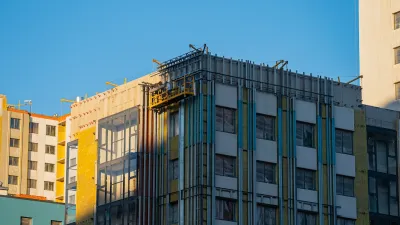Technology and policy are just two factors shaping the future of affordable housing.

As housing costs continue to rise and housing supply tightens, public opinion and policies in the US are shifting to support the development of more affordable housing. That, along with trends in technology and construction, presents a bevy of opportunities for affordable housing in 2024, say Mary Jo Minerich and Amanda Markovic, AIA, of architecture firm GBBN.
In a recent article for Building Design and Construction (BD+C), Minerich and Markovic highlighted several trends they foresee in the upcoming year:
- Emphasis on sustainability, including Passive House design, sustainably sourced material selection, and site selection that fosters sustainable, resilient, and equitable communities.
- Improved aesthetics, moving from bland and neutral designs to well-designed projects that enhance surrounding neighborhoods and counteract historic stigma associated with affordable housing.
- Use of technology to streamline projects, including augmented reality tools for modeling and prefabrication for construction.
- Policy changes, from upzoning and parking exemptions to the creation of new local affordable housing funds.
- Inflation Reduction Act (IRA), which presents opportunities to combine affordable housing initiatives with IRA financial incentives for renewable energy, sustainability, resilient, and equity.
FULL STORY: What's next for affordable housing in 2024?

Alabama: Trump Terminates Settlements for Black Communities Harmed By Raw Sewage
Trump deemed the landmark civil rights agreement “illegal DEI and environmental justice policy.”

Study: Maui’s Plan to Convert Vacation Rentals to Long-Term Housing Could Cause Nearly $1 Billion Economic Loss
The plan would reduce visitor accommodation by 25% resulting in 1,900 jobs lost.

Planetizen Federal Action Tracker
A weekly monitor of how Trump’s orders and actions are impacting planners and planning in America.

Wind Energy on the Rise Despite Federal Policy Reversal
The Trump administration is revoking federal support for renewable energy, but demand for new projects continues unabated.

Passengers Flock to Caltrain After Electrification
The new electric trains are running faster and more reliably, leading to strong ridership growth on the Bay Area rail system.

Texas Churches Rally Behind ‘Yes in God’s Back Yard’ Legislation
Religious leaders want the state to reduce zoning regulations to streamline leasing church-owned land to housing developers.
Urban Design for Planners 1: Software Tools
This six-course series explores essential urban design concepts using open source software and equips planners with the tools they need to participate fully in the urban design process.
Planning for Universal Design
Learn the tools for implementing Universal Design in planning regulations.
Caltrans
Smith Gee Studio
Institute for Housing and Urban Development Studies (IHS)
City of Grandview
Harvard GSD Executive Education
Toledo-Lucas County Plan Commissions
Salt Lake City
NYU Wagner Graduate School of Public Service




























